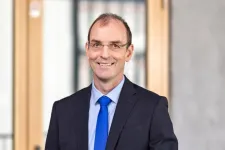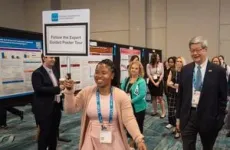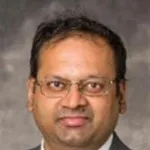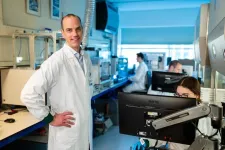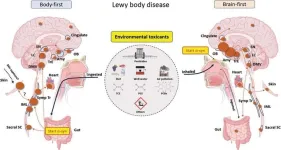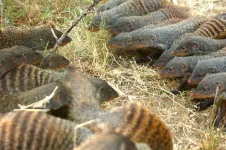(Press-News.org) Many people are familiar with the principle of electronic excitation from their physics lessons: electrons in atoms or molecules absorb energy, typically from light, and rise to a higher energy level. This can have various consequences – in photovoltaic technology, the phenomenon ensures that electricity can be generated from sunlight.
Measuring electronic excitation according to scientific standards and investigating how excited electrons influence each other is a real challenge: “Electronic excitation and the subsequent processes take place extremely quickly, many things happen simultaneously“, explains Tobias Brixner, Chair of Physical Chemistry I at the University of Würzburg (JMU) and also a member of the Faculty of Physics and Astronomy. “The scheme of femtochemistry is well established in research: a molecule is excited by a short flash of light and the temporal change is observed by a delayed second flash of light – as in an extreme slow-motion recording. The flashes last only a few femtoseconds, i.e. millionths of a billionth of a second.“
Despite the many successes of this technology, it is not yet possible to clearly understand the many interactions between multiple excited electrons. Key quantum phenomena remain poorly understood. Brixner and his team [Link: https://go.uniwue.de/brixner] are therefore developing new experimental investigation methods.
From Theory to Application
Recently, Brixner and his collaborators at the University of Ottawa, Canada, developed a new approach to separate the individual contributions of single, double and multiple excitations without overlap for the first time. The researchers demonstrated the method on polymers from the Institute of Organic Chemistry at JMU, as well as on other molecular and biological systems. Brixner reported the results at the 2022 Nobel Symposium for Chemistry in Båstad, Sweden [Link: https://www.uni-wuerzburg.de/en/news-and-events/news/detail/news/wuerzburger-professor-bei-nobelsymposium/], followed by a publication in 2023 in the renowned scientific journal Nature [Link: https://www.uni-wuerzburg.de/en/news-and-events/news/detail/news/endlich-getrennt/] using the example of the “transient absorption“ method.
“The idea of systematically breaking down complex physical processes into more comprehensible individual effects has been known for a hundred years in the context of perturbation theory“, explains Brixner. “Now the concept can also be implemented experimentally in a very simple way.“
The new approach works like this: the molecule is excited with a series of different laser intensities and the time-dependent evolution is observed. At high intensities, there is a high probability that the molecule will be excited twice, three times or even more – at lower intensities, single excitations dominate. By combining all the observations mathematically, the researchers are able to separate the individual contributions not only qualitatively but also quantitatively. This finding, surprising even to experts at the time of publication, is the core principle of the new project.
About the IMPACTS Research Project
The idea will now be extended to other spectroscopic methods and combined with microscopy to obtain information about the interaction of excited states in molecules and materials with temporal and spatial resolution.
The new funding will enable Brixner's team to pursue their research intensively over the next five years. The European Research Council (ERC) has now announced that Brixner will receive an ERC Advanced Grant – an award worth 2.5 million euros for his project “Isolating Multi-Particle Correlations in Time and Space (IMPACTS)“.
This makes Brixner one of the few researchers to have received an ERC grant twice. In 2013, he received an “ERC Consolidator Grant“ (totalling 2.7 million euros) for the career phase between six and twelve years after the doctorate, and now the new prize in the competition for excellent research ideas at all career phases.
About the ERC Awardee
Tobias Brixner has held the Chair of Physical Chemistry I at JMU since 2007. He studied physics in Albuquerque (New Mexico, USA) and Würzburg and received his PhD in 2001 with experimental physicist Gustav Gerber. After a postdoctoral period at the University of California in Berkeley with chemist Graham Fleming (2003 and 2004), he returned to JMU to lead an Emmy Noether junior research group funded by the German Research Foundation (DFG).
Among other things, Brixner has been speaker of the DFG research group “Light-Induced Dynamics in Molecular Aggregates“ (2012 to 2019), dean of the Faculty of Chemistry and Pharmacy (2021 to 2023) and general chair of the “International Conference on Ultrafast Phenomena“ (2024), the largest conference in the field of ultrafast phenomena.
In the field of new digital teaching concepts, Brixner is also developing the award-winning virtual laser laboratory “femtoPro“ [Link: https://www.femtopro.com], which allows students to learn practical work with laser radiation in an eye-safe manner.
Professor Tobias Brixner receives a 2.5 million euro ERC Advanced Grant from the European Research Council. (Image: Christoph Weiß/JMU)
END
ERC Advanced Grant: 2.5 million euros for Tobias Brixner
2024-04-11
ELSE PRESS RELEASES FROM THIS DATE:
Proud seafarers have strong doubts about the safety of autonomous ships
2024-04-11
The maritime profession is among the world’s oldest professions, and today’s shipping is based on long and proud traditions. Professional pride and commitment are often deeply ingrained in seafarers, and for many, the job is more of a way of life. New technologies will bring about major changes in the work of bridge officers, who have the ultimate responsibility on board Norwegian vessels.
Strong doubts about safety
“Bridge officers rely on automated systems that are already found on board, such as advanced autopilot systems. However, there is strong scepticism, almost mistrust, that increased automation and autonomous ...
People who use willpower alone to achieve goals, resist temptation, deemed more trustworthy
2024-04-11
People who use willpower to overcome temptations and achieve their goals are perceived as more trustworthy than those who use strategies that involve external incentives or deterrents – such as swear jars or internet-blocking apps – according to research published by the American Psychological Association.
“The knowledge that people can use external commitment strategies to overcome self-control problems has existed in some form for thousands of years. Since at least the time of Homer and Odysseus, the focus has primarily been on the efficacy of these strategies for the person choosing to engage ...
New study shows effect of socio-economic factors—housing, food, neighborhood—to predict diabetic patients’ risk of heart failure
2024-04-11
CLEVELAND—A recent study by Case Western Reserve University used national data from U.S. military veterans with diabetes to validate and modify a widely accepted model used to predict the risk of heart failure in diabetic patients.
The model, called the WATCH-DM score, is used to predict the likelihood of heart failure in diabetes patients within five years.
But because it overlooks the influence of social determinants of health‚ such as housing, food and a patient’s neighborhood, the researchers used a social deprivation index (SDI), a multi-component summary score, to adjust the WATCH-DM score.
The SDI, introduced by the Robert ...
Mapped: 33 new big game migrations across American West
2024-04-11
RESTON, Va. — A new set of maps that document the movements of ungulates was published today in the fourth volume of the Ungulate Migrations of the Western United States. The maps in this collaborative U.S. Geological Survey report series reveal the migration routes and critical ranges used by ungulates, or hooved mammals, in the western U.S., furthering scientists’ understanding of the geography of big game migrations.
The new volume, “Ungulate Migrations of the Western United States: Volume 4,” documents 33 mule deer, ...
Can we crack the code of cartilage?
2024-04-11
Can Jos Malda crack the code of cartilage?
In our aging society, healing joint problems is becoming increasingly important. To do this, cartilage damage must become repairable. But so far it has proven impossible to recreate the intricate internal structure of cartilage. Professor Jos Malda has now received an ERC Advanced grant of €2.5 million to crack that code.
Bringing biology and technology together
Throughout his career, Jos Malda has been concerned with the interface between biology and technology. It took him from studying Bioprocess Engineering in Wageningen to ...
Moments of clarity in the fog of dementia
2024-04-11
A recent Mayo Clinic study published in Alzheimer's & Dementia: The Journal of the Alzheimer's Association investigated lucid episodes in people living with later stages of dementia, providing insights into how these occurrences reveal themselves.
The findings showed that 75% of people having lucid episodes were reported to have Alzheimer’s Disease as opposed to other forms of dementia.
Researchers define lucid episodes as unexpected, spontaneous, meaningful and relevant communication from a ...
Heart transplant recipient discovers a calling for advocacy, support for others
2024-04-11
11 April, Prague, Czech Republic—Glen Kelley’s journey as a heart transplant recipient came full circle today in Prague, as he addressed attendees of the Annual Meeting and Scientific Sessions of the International Society for Heart and Lung Transplantation (ISHLT), including members of his own care teams.
As a high school senior outside of Peoria, Illinois, Kelley was diagnosed with stage-4 Hodgkin’s lymphoma and underwent eight months of chemotherapy and radiation. After 10 months in remission, the ...
On World Parkinson’s Day, a new theory emerges on the disease’s origins and spread
2024-04-11
The nose or the gut? For the past two decades, the scientific community has debated the wellspring of the toxic proteins at the source of Parkinson’s disease. In 2003, a German pathologist, Heiko Braak, MD, first proposed that the disease begins outside the brain. More recently, Per Borghammer, MD, with Aarhus University Hospital in Denmark, and his colleagues argue that the disease is the result of processes that start in either the brain’s smell center (brain-first) or the body’s intestinal tract (body-first).
A new hypothesis paper appearing in the Journal of Parkinson’s ...
ERC wants to see what shapes the stories AI tells us
2024-04-11
Professor Jill Walker Rettberg, Co-Director of the Centre for Digital Narrative at the University of Bergen, is awarded an ERC Advanced Grant for the project AI STORIES. The grant consists of 2.5 million Euro over 5 years. This is Rettberg's second ERC Grant.
“The AI STORIES project builds on the premise that storytelling is central to human culture, with narratives shaping our understanding of the world. We will study artificial intelligence and how it creates new narratives,” says Rettberg.
Generative AI has been dubbed ...
New project explores warfare in animal societies
2024-04-11
A major new research project will investigate how and why groups of animals from the same species fight one another.
By focussing on warlike species – mongooses and termites – researchers aim to understand how evolution can lead to extreme aggression between groups, the consequences of this and the factors that can lead to peace.
The results will help to explain why violence between rival groups evolves in some species but not others, or between some groups and not others – with implications for our understanding of human evolution.
The research team, led by Professor ...
